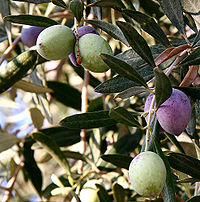
Photo from wikipedia
Thirty‐three new genotypes coming from a table olive cross‐breeding program are evaluated to assess their adaptability to standard processes, namely Spanish‐style and black ripe olives. Different physical and chemical parameters… Click to show full abstract
Thirty‐three new genotypes coming from a table olive cross‐breeding program are evaluated to assess their adaptability to standard processes, namely Spanish‐style and black ripe olives. Different physical and chemical parameters are evaluated in fresh fruits, processed olives, and brines. Most of these traits exhibit large variability among all genotypes and within each cross. Seven new genotypes, 05–138, 05–166, 05–217, 05–322, 05–499, 04–1390, and 04–1396, are selected based on fruit weight, pulp‐to‐pit ratio, olive oil content, and bruising parameters. In particular, two genotypes (04–1355 and 05–271) did not develop fermentation by lactic acid bacteria. Some genotypes had firmness problems in the final product, especially the 02–1000, and in both elaboration processes this cultivar was excessively soft. Other genotypes developed an unacceptable color when they were processed as Spanish‐style olives. Nevertheless, all new genotypes could be elaborated as both Spanish‐style and black ripe olives by adapting specific criteria in the processes for each genotype. Correlations between traits measured in fresh fruit and those measured in processed olives are explored. Practical Applications: Currently, the consumption of table olives is increasing and the table olive industry has a greater problem with the raw material that reaches its cooperatives. The relevance of this work is that almost all genotypes tested have produced a final product of high quality. In addition, they have agronomic advantages over traditional cultivars. It opens up the possibility to employ theses new cultivars to obtain table olives, both Spanish‐style and black ripe olives, with less post‐harvest, and processing problems. New olive genotypes are processed as both Spanish‐style and black ripe olives. An edible final product is obtained.
Journal Title: European Journal of Lipid Science and Technology
Year Published: 2018
Link to full text (if available)
Share on Social Media: Sign Up to like & get
recommendations!